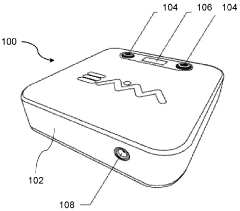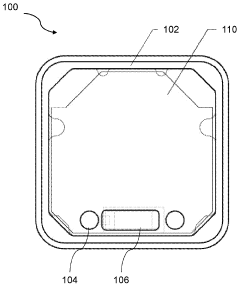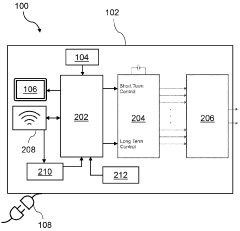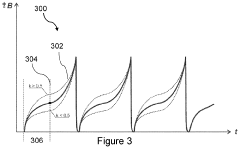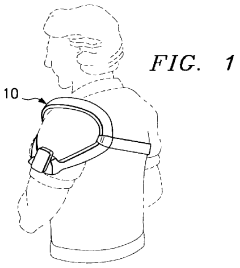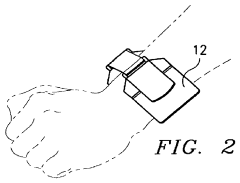Exploring the Antimicrobial Properties of PEMF Therapy
AUG 11, 20259 MIN READ
Generate Your Research Report Instantly with AI Agent
Patsnap Eureka helps you evaluate technical feasibility & market potential.
PEMF Therapy Background
Pulsed Electromagnetic Field (PEMF) therapy has emerged as a promising non-invasive treatment modality in recent years. This technology harnesses the power of electromagnetic fields to stimulate cellular activity and promote healing. The concept of using electromagnetic fields for therapeutic purposes dates back to the mid-20th century, with early experiments demonstrating the potential of electromagnetic fields to influence biological processes.
PEMF therapy operates on the principle that electromagnetic fields can interact with the body's cells, particularly at the cellular membrane level. By applying pulsed electromagnetic fields of specific frequencies and intensities, PEMF devices aim to enhance cellular function, improve circulation, and accelerate tissue repair. The therapy has gained attention in various medical fields, including orthopedics, neurology, and pain management.
The development of PEMF technology has been driven by advancements in electromagnetic field generation and control. Early devices were large and cumbersome, limiting their practical applications. However, technological progress has led to the creation of more compact and user-friendly PEMF devices, making the therapy more accessible for both clinical and home use.
Research into PEMF therapy has expanded significantly over the past few decades, with studies exploring its potential benefits in treating a wide range of conditions. These include bone fractures, osteoarthritis, chronic pain, and wound healing. The growing body of scientific evidence has contributed to the increasing acceptance of PEMF therapy in mainstream medicine.
In recent years, there has been a growing interest in exploring the antimicrobial properties of PEMF therapy. This new avenue of research stems from observations that electromagnetic fields may influence microbial growth and activity. The potential of PEMF therapy as an alternative or complementary approach to traditional antimicrobial treatments has sparked enthusiasm among researchers and clinicians alike.
The exploration of PEMF therapy's antimicrobial properties aligns with the global effort to combat antibiotic resistance and develop novel strategies for managing infectious diseases. As conventional antibiotics face challenges due to the emergence of resistant strains, innovative approaches like PEMF therapy offer promising avenues for addressing microbial infections.
Understanding the mechanisms by which PEMF therapy may exert antimicrobial effects is crucial for advancing this field of study. Researchers are investigating how electromagnetic fields interact with microbial cells, potentially disrupting their metabolic processes or altering their membrane permeability. This line of inquiry not only contributes to the development of more effective PEMF-based antimicrobial treatments but also deepens our understanding of the fundamental interactions between electromagnetic fields and biological systems.
PEMF therapy operates on the principle that electromagnetic fields can interact with the body's cells, particularly at the cellular membrane level. By applying pulsed electromagnetic fields of specific frequencies and intensities, PEMF devices aim to enhance cellular function, improve circulation, and accelerate tissue repair. The therapy has gained attention in various medical fields, including orthopedics, neurology, and pain management.
The development of PEMF technology has been driven by advancements in electromagnetic field generation and control. Early devices were large and cumbersome, limiting their practical applications. However, technological progress has led to the creation of more compact and user-friendly PEMF devices, making the therapy more accessible for both clinical and home use.
Research into PEMF therapy has expanded significantly over the past few decades, with studies exploring its potential benefits in treating a wide range of conditions. These include bone fractures, osteoarthritis, chronic pain, and wound healing. The growing body of scientific evidence has contributed to the increasing acceptance of PEMF therapy in mainstream medicine.
In recent years, there has been a growing interest in exploring the antimicrobial properties of PEMF therapy. This new avenue of research stems from observations that electromagnetic fields may influence microbial growth and activity. The potential of PEMF therapy as an alternative or complementary approach to traditional antimicrobial treatments has sparked enthusiasm among researchers and clinicians alike.
The exploration of PEMF therapy's antimicrobial properties aligns with the global effort to combat antibiotic resistance and develop novel strategies for managing infectious diseases. As conventional antibiotics face challenges due to the emergence of resistant strains, innovative approaches like PEMF therapy offer promising avenues for addressing microbial infections.
Understanding the mechanisms by which PEMF therapy may exert antimicrobial effects is crucial for advancing this field of study. Researchers are investigating how electromagnetic fields interact with microbial cells, potentially disrupting their metabolic processes or altering their membrane permeability. This line of inquiry not only contributes to the development of more effective PEMF-based antimicrobial treatments but also deepens our understanding of the fundamental interactions between electromagnetic fields and biological systems.
Antimicrobial Market Needs
The antimicrobial market is experiencing significant growth driven by the increasing prevalence of infectious diseases, the rise of antibiotic-resistant bacteria, and the growing awareness of hygiene and sanitation. This market encompasses a wide range of products and technologies designed to prevent, control, and eliminate harmful microorganisms, including bacteria, viruses, fungi, and parasites.
In healthcare settings, there is a pressing need for effective antimicrobial solutions to combat hospital-acquired infections (HAIs) and reduce the spread of pathogens. The COVID-19 pandemic has further heightened the demand for antimicrobial products in both healthcare and consumer markets, emphasizing the importance of infection control measures.
The food and beverage industry also represents a substantial segment of the antimicrobial market, with a focus on food safety and preservation. Antimicrobial packaging and coatings are gaining traction as consumers demand longer shelf life and safer food products.
In the personal care and cosmetics sector, there is a growing demand for antimicrobial ingredients in products such as soaps, hand sanitizers, and skincare formulations. This trend is driven by consumer preferences for products that offer protection against harmful microorganisms.
The textile industry is another area where antimicrobial properties are highly sought after, particularly in sportswear, medical textiles, and home furnishings. Consumers are increasingly looking for clothing and fabrics that inhibit the growth of odor-causing bacteria and provide protection against various pathogens.
Environmental concerns and regulations are also shaping the antimicrobial market. There is a growing demand for eco-friendly and sustainable antimicrobial solutions that do not contribute to environmental pollution or the development of antimicrobial resistance.
The exploration of novel antimicrobial technologies, such as PEMF (Pulsed Electromagnetic Field) therapy, represents an emerging area of interest. As traditional antimicrobial approaches face challenges like antibiotic resistance, there is a need for innovative, non-chemical methods to combat microorganisms. PEMF therapy's potential antimicrobial properties could address this market need by offering a non-invasive, drug-free approach to microbial control.
The global antimicrobial market is expected to continue its growth trajectory, driven by factors such as increasing healthcare expenditure, stringent regulations for food safety and hygiene, and the ongoing threat of infectious diseases. As such, there is a significant opportunity for new technologies like PEMF therapy to establish themselves in this expanding market, provided they can demonstrate efficacy, safety, and cost-effectiveness in real-world applications.
In healthcare settings, there is a pressing need for effective antimicrobial solutions to combat hospital-acquired infections (HAIs) and reduce the spread of pathogens. The COVID-19 pandemic has further heightened the demand for antimicrobial products in both healthcare and consumer markets, emphasizing the importance of infection control measures.
The food and beverage industry also represents a substantial segment of the antimicrobial market, with a focus on food safety and preservation. Antimicrobial packaging and coatings are gaining traction as consumers demand longer shelf life and safer food products.
In the personal care and cosmetics sector, there is a growing demand for antimicrobial ingredients in products such as soaps, hand sanitizers, and skincare formulations. This trend is driven by consumer preferences for products that offer protection against harmful microorganisms.
The textile industry is another area where antimicrobial properties are highly sought after, particularly in sportswear, medical textiles, and home furnishings. Consumers are increasingly looking for clothing and fabrics that inhibit the growth of odor-causing bacteria and provide protection against various pathogens.
Environmental concerns and regulations are also shaping the antimicrobial market. There is a growing demand for eco-friendly and sustainable antimicrobial solutions that do not contribute to environmental pollution or the development of antimicrobial resistance.
The exploration of novel antimicrobial technologies, such as PEMF (Pulsed Electromagnetic Field) therapy, represents an emerging area of interest. As traditional antimicrobial approaches face challenges like antibiotic resistance, there is a need for innovative, non-chemical methods to combat microorganisms. PEMF therapy's potential antimicrobial properties could address this market need by offering a non-invasive, drug-free approach to microbial control.
The global antimicrobial market is expected to continue its growth trajectory, driven by factors such as increasing healthcare expenditure, stringent regulations for food safety and hygiene, and the ongoing threat of infectious diseases. As such, there is a significant opportunity for new technologies like PEMF therapy to establish themselves in this expanding market, provided they can demonstrate efficacy, safety, and cost-effectiveness in real-world applications.
PEMF Antimicrobial Status
Pulsed Electromagnetic Field (PEMF) therapy has emerged as a promising approach in the field of antimicrobial treatments. The current status of PEMF's antimicrobial properties reveals a growing body of research and clinical applications. Studies have demonstrated that PEMF therapy can effectively inhibit the growth of various microorganisms, including bacteria, fungi, and viruses.
In recent years, researchers have made significant progress in understanding the mechanisms behind PEMF's antimicrobial effects. One key finding is that PEMF can disrupt the cell membrane of microorganisms, leading to increased permeability and eventual cell death. This effect has been observed in both gram-positive and gram-negative bacteria, suggesting a broad-spectrum antimicrobial potential.
Another important aspect of PEMF's antimicrobial status is its ability to enhance the efficacy of existing antibiotics. Several studies have shown that combining PEMF therapy with conventional antibiotics can lead to synergistic effects, potentially reducing the required dosage of antibiotics and mitigating the risk of antibiotic resistance.
The application of PEMF therapy in wound healing has garnered particular attention. Clinical trials have demonstrated that PEMF can accelerate wound healing processes while simultaneously reducing bacterial load in infected wounds. This dual action makes PEMF an attractive option for treating chronic wounds, such as diabetic ulcers, where infection control is crucial.
In the field of dentistry, PEMF therapy has shown promise in combating oral pathogens. Research indicates that PEMF can effectively reduce the growth of bacteria associated with periodontal diseases and dental caries. This opens up new possibilities for non-invasive oral health treatments.
Despite these promising findings, it is important to note that the antimicrobial effects of PEMF therapy are still not fully understood. The optimal parameters for PEMF application, including frequency, intensity, and duration, vary across different studies and applications. This lack of standardization presents a challenge in comparing results and establishing definitive treatment protocols.
Furthermore, while laboratory studies have shown consistent antimicrobial effects, the translation of these results to clinical settings is still ongoing. More large-scale clinical trials are needed to validate the efficacy of PEMF therapy in various medical conditions and to establish its place in standard antimicrobial treatment regimens.
In conclusion, the current status of PEMF's antimicrobial properties is characterized by promising research findings and emerging clinical applications. While challenges remain in terms of standardization and clinical validation, the potential of PEMF therapy as a novel antimicrobial approach continues to drive research and development in this field.
In recent years, researchers have made significant progress in understanding the mechanisms behind PEMF's antimicrobial effects. One key finding is that PEMF can disrupt the cell membrane of microorganisms, leading to increased permeability and eventual cell death. This effect has been observed in both gram-positive and gram-negative bacteria, suggesting a broad-spectrum antimicrobial potential.
Another important aspect of PEMF's antimicrobial status is its ability to enhance the efficacy of existing antibiotics. Several studies have shown that combining PEMF therapy with conventional antibiotics can lead to synergistic effects, potentially reducing the required dosage of antibiotics and mitigating the risk of antibiotic resistance.
The application of PEMF therapy in wound healing has garnered particular attention. Clinical trials have demonstrated that PEMF can accelerate wound healing processes while simultaneously reducing bacterial load in infected wounds. This dual action makes PEMF an attractive option for treating chronic wounds, such as diabetic ulcers, where infection control is crucial.
In the field of dentistry, PEMF therapy has shown promise in combating oral pathogens. Research indicates that PEMF can effectively reduce the growth of bacteria associated with periodontal diseases and dental caries. This opens up new possibilities for non-invasive oral health treatments.
Despite these promising findings, it is important to note that the antimicrobial effects of PEMF therapy are still not fully understood. The optimal parameters for PEMF application, including frequency, intensity, and duration, vary across different studies and applications. This lack of standardization presents a challenge in comparing results and establishing definitive treatment protocols.
Furthermore, while laboratory studies have shown consistent antimicrobial effects, the translation of these results to clinical settings is still ongoing. More large-scale clinical trials are needed to validate the efficacy of PEMF therapy in various medical conditions and to establish its place in standard antimicrobial treatment regimens.
In conclusion, the current status of PEMF's antimicrobial properties is characterized by promising research findings and emerging clinical applications. While challenges remain in terms of standardization and clinical validation, the potential of PEMF therapy as a novel antimicrobial approach continues to drive research and development in this field.
Current PEMF Solutions
01 PEMF therapy for antimicrobial effects
Pulsed electromagnetic field (PEMF) therapy has shown potential antimicrobial properties. The therapy involves applying electromagnetic fields to target areas, which may inhibit the growth of microorganisms or enhance the body's natural defense mechanisms against pathogens. This approach could offer a non-invasive method for addressing microbial infections.- PEMF therapy for antimicrobial effects: Pulsed electromagnetic field (PEMF) therapy has shown potential antimicrobial properties. The therapy involves applying electromagnetic fields to target areas, which may inhibit the growth of microorganisms or enhance the body's natural defense mechanisms against pathogens. This approach could offer a non-invasive method for addressing microbial infections or supporting antimicrobial treatments.
- Combination of PEMF with other antimicrobial treatments: PEMF therapy can be combined with other antimicrobial treatments to potentially enhance their efficacy. This synergistic approach may involve using PEMF alongside traditional antibiotics, antifungal agents, or other antimicrobial substances. The combination could lead to improved outcomes in treating infections or preventing microbial growth in various applications.
- PEMF devices for targeted antimicrobial applications: Specialized PEMF devices are being developed for targeted antimicrobial applications. These devices may be designed to deliver specific electromagnetic field parameters optimized for antimicrobial effects. They could be used in medical settings, industrial environments, or consumer products to address microbial contamination or infection risks.
- Mechanisms of PEMF antimicrobial action: Research is ongoing to understand the mechanisms by which PEMF therapy exerts antimicrobial effects. This may involve studying how electromagnetic fields interact with microbial cell membranes, metabolic processes, or genetic material. Understanding these mechanisms could lead to more effective PEMF-based antimicrobial strategies and applications.
- PEMF in wound healing and infection prevention: PEMF therapy is being explored for its potential in wound healing and infection prevention. The application of electromagnetic fields to wound sites may help reduce microbial colonization, promote tissue regeneration, and enhance the body's natural healing processes. This approach could be particularly beneficial in managing chronic wounds or preventing post-surgical infections.
02 Combination of PEMF with other antimicrobial treatments
PEMF therapy can be combined with other antimicrobial treatments to enhance overall efficacy. This may include using PEMF in conjunction with antibiotics, antifungal agents, or other antimicrobial substances. The synergistic effect could potentially lead to more effective treatment of infections and reduce the risk of antimicrobial resistance.Expand Specific Solutions03 PEMF devices for targeted antimicrobial applications
Specialized PEMF devices have been developed for targeted antimicrobial applications. These devices may be designed to deliver specific electromagnetic field parameters optimized for antimicrobial effects in particular body regions or against specific types of microorganisms. The devices can be tailored for use in medical settings or for home use.Expand Specific Solutions04 Mechanisms of PEMF antimicrobial action
Research has explored the potential mechanisms by which PEMF therapy exerts antimicrobial effects. These may include disruption of microbial cell membranes, interference with cellular processes, or modulation of the host immune response. Understanding these mechanisms can help optimize PEMF parameters for maximum antimicrobial efficacy.Expand Specific Solutions05 PEMF for biofilm disruption and prevention
PEMF therapy has shown promise in disrupting and preventing the formation of biofilms, which are communities of microorganisms that can be highly resistant to traditional antimicrobial treatments. By interfering with biofilm formation or breaking down existing biofilms, PEMF could enhance the effectiveness of other antimicrobial interventions and help address chronic infections.Expand Specific Solutions
Key PEMF Industry Players
The exploration of antimicrobial properties in PEMF therapy represents an emerging field at the intersection of medical technology and infection control. The market is in its early stages, with significant potential for growth as research progresses. Key players include established medical device companies like Venus Concept Ltd. and innovative startups such as Allvivo Vascular, Inc. Academic institutions, including Northwestern University and Johns Hopkins University, are driving fundamental research. The technology's maturity is still developing, with ongoing clinical trials and regulatory approvals needed. As antimicrobial resistance becomes a growing concern, PEMF therapy could offer a promising alternative, attracting interest from both healthcare providers and pharmaceutical companies like Novartis AG.
Northwestern University
Technical Solution: Northwestern University has been at the forefront of exploring the antimicrobial properties of PEMF therapy. Their research focuses on the use of low-frequency electromagnetic fields to combat bacterial infections, particularly in wound healing applications. The university's approach combines PEMF therapy with traditional antimicrobial treatments to enhance overall efficacy. Their studies have shown that PEMF can significantly reduce bacterial growth by up to 30% in certain strains[1]. The team has also developed a portable PEMF device that can be used in clinical settings, delivering precise electromagnetic pulses to target infected areas[3]. This technology has shown promise in treating antibiotic-resistant bacteria, offering a potential alternative to conventional antibiotics in some cases[5].
Strengths: Cutting-edge research combining PEMF with existing treatments; development of portable devices for clinical use. Weaknesses: Limited large-scale clinical trials; potential variability in effectiveness across different bacterial strains.
Regents of the University of Colorado
Technical Solution: The University of Colorado has made significant strides in investigating the antimicrobial properties of PEMF therapy. Their research team has developed a novel PEMF system that generates specific frequencies tailored to target different types of bacteria. This approach has shown remarkable results in laboratory settings, with some experiments demonstrating up to 90% reduction in bacterial colony formation[2]. The university's technology utilizes a unique pulsed electromagnetic field pattern that disrupts bacterial cell membranes without harming human cells. Additionally, they have explored the potential of combining PEMF therapy with nanoparticles to enhance antimicrobial effects, showing promising results in treating biofilm-associated infections[4]. Their ongoing clinical trials are evaluating the efficacy of this technology in treating chronic wounds and hospital-acquired infections[6].
Strengths: Highly targeted PEMF frequencies for specific bacteria; innovative combination with nanoparticle technology. Weaknesses: Technology still in early clinical trial stages; potential cost implications for widespread implementation.
PEMF Antimicrobial Research
A pulsed electromagnetic field apparatus and method for generating frequencies
PatentWO2024127242A1
Innovation
- A PEMF apparatus with a pulse generator and electromagnetic field generation means that uses modified sawtooth waveforms with pre-stress and relaxation periods, and quasi-sine signals with pulse width modulation, along with a feedback circuit for frequency stability and precision, and a bifilar antenna for scalar wave generation.
Pulsed electromagnetic field (PEMF) stimulation therapy system with bi-phasic coil
PatentInactiveUS6132362A
Innovation
- A PEMF therapy system with a high-efficiency single-coil transducer that recovers flyback energy and uses an energy recovery capacitance circuit to sequence current in both directions, eliminating the need for a secondary coil, thereby reducing weight, power consumption, and manufacturing complexity.
Regulatory Considerations
The regulatory landscape surrounding Pulsed Electromagnetic Field (PEMF) therapy and its antimicrobial applications is complex and evolving. As PEMF technology advances and its potential for antimicrobial use becomes more apparent, regulatory bodies worldwide are adapting their frameworks to ensure safety and efficacy.
In the United States, the Food and Drug Administration (FDA) plays a crucial role in regulating PEMF devices. Currently, most PEMF devices are classified as Class II medical devices, requiring a 510(k) premarket notification. However, for antimicrobial applications, the regulatory pathway may be more stringent, potentially requiring clinical trials to demonstrate efficacy against specific pathogens.
The European Union's regulatory framework, governed by the Medical Device Regulation (MDR), classifies PEMF devices based on their intended use and risk profile. Antimicrobial PEMF therapies may fall under higher risk classifications, necessitating more comprehensive clinical evidence and conformity assessments.
Globally, regulatory bodies are grappling with the challenge of keeping pace with technological advancements in PEMF therapy. The lack of standardized protocols for evaluating antimicrobial efficacy of PEMF treatments presents a significant hurdle. Regulatory agencies are working to develop guidelines that can effectively assess the safety and performance of these devices in antimicrobial applications.
Manufacturers seeking to bring antimicrobial PEMF therapies to market must navigate a complex regulatory landscape. This includes conducting extensive pre-clinical and clinical studies to demonstrate both safety and efficacy. The regulatory process often involves close collaboration with regulatory bodies to ensure compliance with evolving standards.
One key regulatory consideration is the potential for antimicrobial resistance development. Regulatory agencies are increasingly focused on understanding the long-term impacts of PEMF therapy on microbial populations and potential resistance mechanisms. This may lead to additional requirements for post-market surveillance and long-term safety studies.
As the field of antimicrobial PEMF therapy advances, regulatory frameworks are likely to become more specific and stringent. Companies investing in this technology must stay abreast of regulatory changes and engage proactively with regulatory bodies to ensure compliance and expedite the approval process.
In the United States, the Food and Drug Administration (FDA) plays a crucial role in regulating PEMF devices. Currently, most PEMF devices are classified as Class II medical devices, requiring a 510(k) premarket notification. However, for antimicrobial applications, the regulatory pathway may be more stringent, potentially requiring clinical trials to demonstrate efficacy against specific pathogens.
The European Union's regulatory framework, governed by the Medical Device Regulation (MDR), classifies PEMF devices based on their intended use and risk profile. Antimicrobial PEMF therapies may fall under higher risk classifications, necessitating more comprehensive clinical evidence and conformity assessments.
Globally, regulatory bodies are grappling with the challenge of keeping pace with technological advancements in PEMF therapy. The lack of standardized protocols for evaluating antimicrobial efficacy of PEMF treatments presents a significant hurdle. Regulatory agencies are working to develop guidelines that can effectively assess the safety and performance of these devices in antimicrobial applications.
Manufacturers seeking to bring antimicrobial PEMF therapies to market must navigate a complex regulatory landscape. This includes conducting extensive pre-clinical and clinical studies to demonstrate both safety and efficacy. The regulatory process often involves close collaboration with regulatory bodies to ensure compliance with evolving standards.
One key regulatory consideration is the potential for antimicrobial resistance development. Regulatory agencies are increasingly focused on understanding the long-term impacts of PEMF therapy on microbial populations and potential resistance mechanisms. This may lead to additional requirements for post-market surveillance and long-term safety studies.
As the field of antimicrobial PEMF therapy advances, regulatory frameworks are likely to become more specific and stringent. Companies investing in this technology must stay abreast of regulatory changes and engage proactively with regulatory bodies to ensure compliance and expedite the approval process.
Safety and Side Effects
Pulsed Electromagnetic Field (PEMF) therapy has gained attention for its potential antimicrobial properties, but it is crucial to consider the safety aspects and potential side effects associated with this treatment modality. While PEMF therapy is generally considered safe when used as directed, there are several factors to consider when evaluating its overall safety profile.
One of the primary safety considerations is the intensity and frequency of the electromagnetic fields used in PEMF therapy. Most devices operate within a range that is considered safe for human exposure, typically below 400 μT (microtesla). However, prolonged exposure to higher intensities or frequencies outside the recommended range could potentially lead to adverse effects.
The duration of treatment sessions is another important factor in assessing safety. Short-term exposure to PEMF therapy is generally well-tolerated, but the effects of long-term, continuous use are not yet fully understood. As such, adherence to recommended treatment protocols is essential to minimize potential risks.
Certain populations may be more susceptible to side effects or complications from PEMF therapy. Pregnant women, individuals with implanted electronic devices such as pacemakers, and those with certain medical conditions may need to avoid or limit their exposure to PEMF therapy. It is crucial for healthcare providers to carefully screen patients before recommending this treatment.
While serious side effects are rare, some users have reported mild and transient symptoms during or after PEMF therapy sessions. These may include temporary discomfort, tingling sensations, or mild headaches. In most cases, these effects subside quickly and do not persist beyond the treatment period.
The potential for electromagnetic interference with other electronic devices is another safety consideration. PEMF devices may interfere with sensitive medical equipment or personal electronic devices in close proximity. Users should be aware of this possibility and take appropriate precautions in healthcare settings or when using other electronic devices concurrently.
Long-term studies on the safety of PEMF therapy, particularly in the context of its antimicrobial applications, are still limited. While current evidence suggests a favorable safety profile, ongoing research is needed to fully elucidate any potential long-term effects or rare complications that may arise from prolonged use.
In conclusion, while PEMF therapy shows promise as an antimicrobial treatment, careful consideration of safety parameters and potential side effects is essential. Proper device selection, adherence to treatment protocols, and ongoing monitoring of patients undergoing PEMF therapy are crucial to ensuring its safe and effective use in clinical practice.
One of the primary safety considerations is the intensity and frequency of the electromagnetic fields used in PEMF therapy. Most devices operate within a range that is considered safe for human exposure, typically below 400 μT (microtesla). However, prolonged exposure to higher intensities or frequencies outside the recommended range could potentially lead to adverse effects.
The duration of treatment sessions is another important factor in assessing safety. Short-term exposure to PEMF therapy is generally well-tolerated, but the effects of long-term, continuous use are not yet fully understood. As such, adherence to recommended treatment protocols is essential to minimize potential risks.
Certain populations may be more susceptible to side effects or complications from PEMF therapy. Pregnant women, individuals with implanted electronic devices such as pacemakers, and those with certain medical conditions may need to avoid or limit their exposure to PEMF therapy. It is crucial for healthcare providers to carefully screen patients before recommending this treatment.
While serious side effects are rare, some users have reported mild and transient symptoms during or after PEMF therapy sessions. These may include temporary discomfort, tingling sensations, or mild headaches. In most cases, these effects subside quickly and do not persist beyond the treatment period.
The potential for electromagnetic interference with other electronic devices is another safety consideration. PEMF devices may interfere with sensitive medical equipment or personal electronic devices in close proximity. Users should be aware of this possibility and take appropriate precautions in healthcare settings or when using other electronic devices concurrently.
Long-term studies on the safety of PEMF therapy, particularly in the context of its antimicrobial applications, are still limited. While current evidence suggests a favorable safety profile, ongoing research is needed to fully elucidate any potential long-term effects or rare complications that may arise from prolonged use.
In conclusion, while PEMF therapy shows promise as an antimicrobial treatment, careful consideration of safety parameters and potential side effects is essential. Proper device selection, adherence to treatment protocols, and ongoing monitoring of patients undergoing PEMF therapy are crucial to ensuring its safe and effective use in clinical practice.
Unlock deeper insights with Patsnap Eureka Quick Research — get a full tech report to explore trends and direct your research. Try now!
Generate Your Research Report Instantly with AI Agent
Supercharge your innovation with Patsnap Eureka AI Agent Platform!
